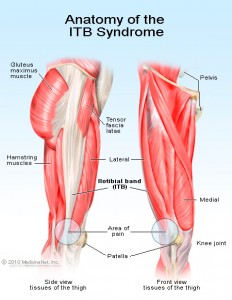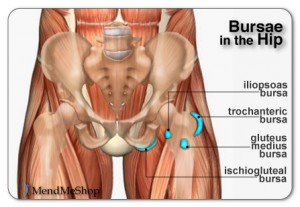I.T. Band, Hip and Lateral Thigh Pain
The iliotibial band is a tissue that runs from our hip down the outside of the leg to the knee. It’s attachment is from a group of muscles from the Glutes and hip to the outside of the knee and works as a helper or stabilizer. When this tissue becomes inflamed, over used, or injured the pain can be severe and last a long time. Some of the symptoms can include: a snapping sensation to the hip or thigh, sharp stabbing pain, going up stairs/hill, prolonged standing, walking, running, laying in bed on or off of that side and trauma. I.T. Band pain can cause a wide range of discomfort from occasional and mild to constant and severe.
Treatment Goals: Reduce inflammation, decrease I.T.Band tension. This can be done with floor or therapy ball stretches,ICE, Ultrasound, manual stretches, foam roller and K.T. tape which applies a small amount of stretch over a long period of time.
This is a common injury we treat all of the time in our office due to the number of runners in our area. Dr. Clay treats this condition by identifying the problem, performing the correct treatment, looking for the cause and educating the patient on what can be done at home to speed up recovery. There are a number of stretches that can be learned quickly to effectively treat this condition at home.
Bursitis can be a source of pain at many joints including the hip and knee. Bursitis is inflammation of a Bursae. This is a small fluid filled sac that acts like a bumper to protect soft tissues that travel across bones and prevents them from rubbing on these hard surfaces. A Bursae can become inflamed which causes it to swell, enlarge, and very painful. Sitting, laying on your side, walking/standing for a long time can all cause bursitis to hurt more. This can be mild or severe pain even with light pressure over the bursae.
This is another common issue we see in our office each week that Dr. Clay treats. There are a number of physical treatments that can lower the pain and speed up recovery, such as: Low Level Laser, taping, passive mobilization, rest and ice.
If you have any questions about this or other problems, Dr. Clay is willing to perform a consultation with you and answer all of your questions.
© Grace Chiropractic. All rights reserved. | Website Design and Hosting by Visual Edge Design



No Comments